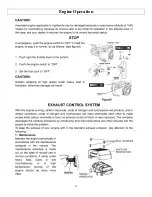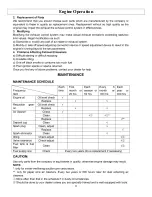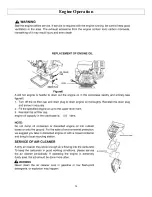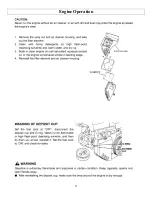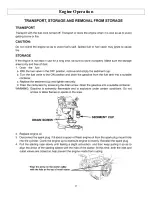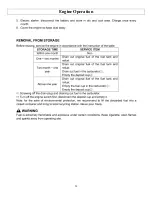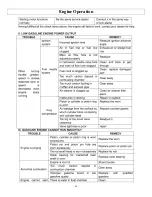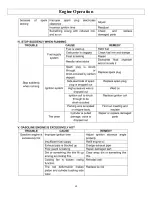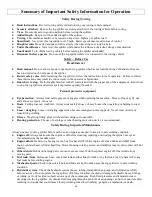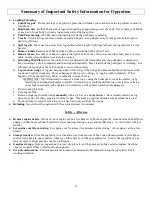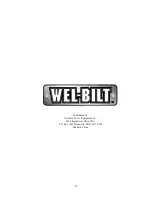
Summary of Important Safety Information for Operation
65
Therefore, the following instructions should be heeded at all times when inspecting or servicing the hydraulic
components of the log splitter:
o
Do not remove the hydraulic oil fill cap when the engine is running. Hot oil can escape causing severe
burns. Allow log splitter to cool completely before removing hydraulic oil fill cap.
o
Do not adjust the pressure setting of the pump or valve.
o
Do not check for leaks with your hand. Leaks can be located by holding a piece of cardboard or wood (at
least two feet long) with your hand at one end and passing the other end over the suspected area (wear eye
protection). Look for discoloration of the cardboard or wood.
o
Stop the engine, disconnect the spark plug, and move all control valve handles back and forth to relieve
pressure before changing or adjusting hydraulic system components such as hoses, tubing, fittings or
other components.
o
If injured by escaping fluid, no matter how small the wound is, see a doctor at once. A typical injection
injury may be a small puncture wound that does not look serious. However, severe infection or reaction
can result if proper medical treatment is not administered immediately by a doctor who is familiar with
injection injuries.
Spark arrestor muffler
. If the engine is equipped with a spark arrestor muffler, clean and inspect it regularly
(follow manufacturer’s service instructions). Replace if damaged.
Tires
. Be sure tires are in good condition before towing the splitter.
Safety During Fueling
Gasoline is highly flammable and explosive. You can be burned or seriously injured when handling fuel. Use extreme
care when handling gasoline:
Fuel outdoors
. Fill fuel tank outdoors – never indoors. Gasoline vapors can ignite if they collect inside an enclosure.
Explosion can result.
Use approved container
. Never pump fuel directly into engine at gas station. Static charge can build and ignite fuel.
Use an UL approved fuel container to transfer gas to the engine.
Running / hot engine
. A running engine is hot enough to ignite fuel. Never add fuel or remove gas cap if engine is
running or still hot. Stop the engine and allow to cool, at least two minutes before adding fuel.
Heat / flames / sparks
. Stay away from sources of heat, flame, or sparks while adding fuel.
Don’t overfill
. DO NOT overfill the gas tank. Allow at least 1/2‖ of empty space below the fill neck to allow for
fuel expansion.
Replace cap
. Replace gas cap securely before starting engine.
Spills
. Clean up fuel spills immediately. Move log splitter away from spilled fuel on the ground. Wipe fuel off
engine and wait 5 minutes for excess fuel to evaporate before starting engine. Gas soaked rags should be disposed of
properly.
On skin / clothes
. If gasoline is spilled on your skin or clothes, change clothes and wash skin immediately.
Gasoline storage
. Store gasoline in a cool, dry place in an UL approved, tightly sealed container.
Safety in Work Site Selection / Set-up
●
Spark arrestor
. If your splitter will be used near any unimproved forest, brush, or grassy covered land, then engine
should be equipped with a spark arrestor. See the ―Specifications‖ section of this manual to determine if your splitter
already has a spark arrestor. Make sure you comply with applicable local, state and federal codes.
●
Hot exhaust.
Hot exhaust fumes from engine can cause fire. Position muffler at least 7’ from combustible objects
during operation.
●
Fire extinguisher
. Have a Class B fire extinguisher available as a precautionary measure when operating the log
splitter in dry areas.
●
Level, dry surface
. To prevent accidental falls and equipment tip over, make sure the splitter is situated on a dry,
level surface with good footing. Stay clear of areas with mud, ice, tall grass, weeds, or brush.
●
Block wheels
. Always block the wheels to prevent unintended movement of the log splitter.
Summary of Contents for M141300A
Page 2: ...Hazard Signal Word Definitions 2...
Page 6: ...Safety Label Locations 6 1 7 2 3 4...
Page 7: ...Safety Label Locations 7 8 5 13 12 10 11 14...
Page 8: ...Safety Label Locations 8 15 16 19 18 17 9 6...
Page 33: ...Parts Breakdown Exploded View 141300 Rev A 33...
Page 39: ...Parts Breakdown Exploded View 141300 Rev A 39...
Page 42: ...Engine Parts Breakdown Exploded View 141300 Rev A 42...
Page 47: ...Engine Operation 47...
Page 48: ...Engine Operation 48...
Page 49: ...Engine Operation 49...
Page 50: ...Engine Operation 50...
Page 51: ...Engine Operation 51...
Page 52: ...Engine Operation 52...
Page 53: ...Engine Operation 53...
Page 54: ...Engine Operation 54...
Page 55: ...Engine Operation 55...
Page 56: ...Engine Operation 56...
Page 57: ...Engine Operation 57...
Page 58: ...Engine Operation 58...
Page 59: ...Engine Operation 59...
Page 60: ...Engine Operation 60...
Page 61: ...Engine Operation 61...
Page 62: ...Engine Operation 62...
Page 63: ...Engine Operation 63...


